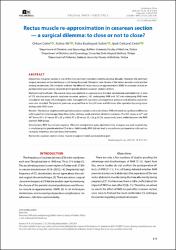Rectus muscle re-approximation in cesarean section - a surgical dilemma: To close or not to close?

View/
Access
info:eu-repo/semantics/openAccesshttp://creativecommons.org/licenses/by-nc-nd/3.0/us/Date
2024Metadata
Show full item recordAbstract
Objectives: Cesarean section is one of the most common operations worldwide since decades. However, the optimum surgical cesarean section technique is still being discussed. Closure or non-closure of the rectus muscles is also unclear among obstetricians. We aimed to evaluate the effect of rectus muscle re-approximation (RMR) in cesarean section on postoperative pain among singleton primi gravida elective cesarean sections at term. Material and methods: The current study was planned as a prospective, blinded, randomized controlled trial. A total of 279 elective primi gravida singleton cesarean sections; 142 undergoing RMR and 137 not-undergoing RMR were included in the study. All participants were managed with our clinic's postoperative protocol and obstetric outcomes were also recorded. The patients' pain was assessed face to face 24 hours and 48 hours after operation by using visual Results: The elective singleton primi gravida cesarean sections with and without RMR exhibited no significant difference with respect to maternal age, Body Mass Index, delivery week and other obstetric outcomes. The VAS scores at 24th and 48th hours (67 +/- 24 versus 69 +/- 25, p: 0.635; 47 +/- 25 versus 52 +/- 26, p: 0,126, respectively) were similar between the RMR and non-RMR group. Conclusions: RMR has not any negative effect on postoperative pain, operation time, analgesic use and hospital stay in singleton primi gravida elective CS at term. Additionally, RMR did not lead to any adverse postoperative risks such as increased blood loss and sub-rectus hematoma.
Source
Ginekologia PolskaVolume
95Issue
10Collections
The following license files are associated with this item:


















